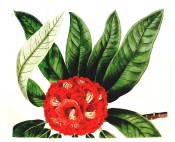Rhododendron arboreum Sm.
Evergreen tree with lance-shaped, wrinkled leaves, to 19cm long, with dense trusses of tubular-bell-shaped, red, pink or white flowers, to 5cm long, with black spots inside, in spring. To 12m by 4m. [RHSE, Hortus, Hilliers’, Millais].
Horticultural & Botanical History
‘ “This most magnificent species of Rhododendron was first noticed by Capt. Hardwicke, on a tour of Sirenagur in 1796, growing in the mountainous tract called the Sewalic chain, which separates the plains of Hindostan, between 750 and 850 east longitude, from the Himmaleh Mountains. It is generally found in elevated situations, in forests of oak; the soil a rich black vegetable earth on a stony bed. The natives use the wood for making the stocks of matchlocks, or common musquets of Hindostan. The stem is columnar, 20 feet or more in height, 16 to 24 inches in diameter.” Thus far Sir James Smith, by whom this superb plant was first published in the Exotic Botany. The figure in that valuable work, taken in India from a wild specimen of the plant, agrees well with the subject of this page, in all respects, except in not representing any of the dark spots of the throat of the corolla, which are so conspicuous in the plant of our gardens. It is now several years since the present plant was raised in this country from seed, but not till within a few weeks had it produced its blossoms, in any collection in Europe. In the beginning of April we were kindly supplied with the specimen from which our figure has been taken by Mrs. Alexander Baring, under the judicious management of whose Gardener at the Grange, Mr. Peter M’Arthur, the plant had expanded its flowers in all their beauty. It may easily be imagined, that this will be, at some future time, the most conspicuous ornament of our shrubberies. In its own country, it thrives only in very cold districts, and with us, such young plants as have been established in the open air seem quite regardless of the severity of European winters.’ [BR f.890/1825]. It was probably introduced to cultivation somewhat later by Dr. Wallich. [MB p.101/1834]. The variety roseum, synonym R. puniceum Rhox., was figured in the Botanical Register. [BR f.1240/1829]. OFG f.1/1854.
History at Camden Park
Listed in the 1845, 1850 and 1857 catalogues [T.825/1845]. Macarthur reported to Loddiges’ Nursery that R. arboreum was one of only a handful of plants from the latest importation from them likely to die. It may have been subsequently obtained from Kew Gardens. It was included among desiderata in a letter to Sir William Hooker on 11th February 1848 [MP A2933-1, p.165] but was not marked ‘arrived’ on Macarthur’s copy. It was requested again of Kew on 1st February, 1849 []MP A2933-1, p.177. The variety arboreum roseum was requested of Loddiges’ Nursery on 16th April 1846 [MP A2933-1, p.147] but not subsequently recorded.
Notes
Published Jun 18, 2009 - 02:26 PM | Last updated Jul 18, 2010 - 12:40 PM
| Family | Ericaceae |
|---|---|
| Category | |
| Region of origin | Himalayas, China and south east Asia |
| Synonyms |
|
| Common Name | Tree Rhododendron |
| Name in the Camden Park Record | Rhododendron arboreum – Tree Rhododendron |
| Confidence level | high |


